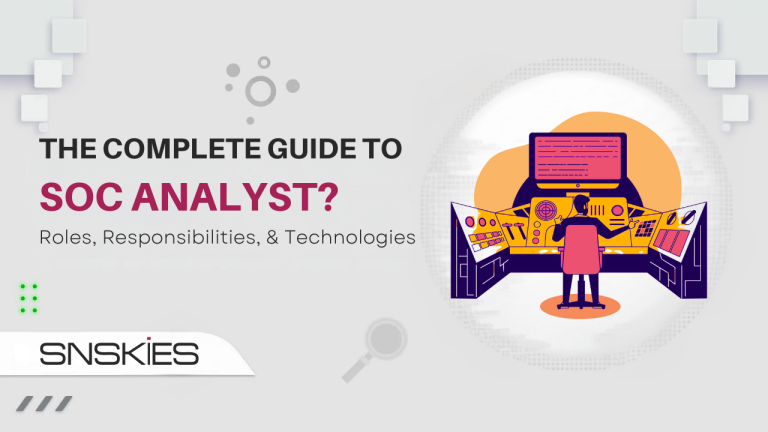The Complete Guide to SoC Analysts: Roles, Responsibilities, and Technologies
The Complete Guide to SoC Analysts: Roles, Responsibilities, and Technologies
- Articles
- December 19, 2024

Cybersecurity threats are growing more sophisticated, making the role of a Security Operations Center (SoC) critical for businesses of all sizes. SoC Analysts form the backbone of this operation, leveraging advanced tools and frameworks to monitor, detect, and neutralize cyber threats.
In this comprehensive guide, we’ll dive into the essential concepts, roles, and technologies associated with SoC Analysts, structured to provide you with a detailed and engaging overview.
What is a Security Operations Center (SoC)?
A Security Operations Center (SoC) is a centralized unit where cybersecurity experts continuously monitor an organization’s digital environment for threats, vulnerabilities, and breaches. The SoC’s primary objective is to:
- Detect potential cyber threats.
- Investigate security incidents.
- Respond promptly to minimize damage.
Key Technologies in a SoC
Understanding SIEM (Security Information and Event Management)
SIEM is a critical technology in any SoC. It integrates:
- SIM (Security Information Management): Collects and stores security data from various systems.
- SEM (Security Event Management): Monitors, analyzes, and reports security events in real-time.
Features and Uses of SIEM
- Log Collection: Gathers logs from multiple systems and devices.
- Log Aggregation: Combines logs into a centralized location for analysis.
- Categorization: Classifies logs to identify patterns.
- Rule-Based Alerts: Triggers alerts based on predefined rules.
- Artificial Intelligence: Enhances threat detection using machine learning.
- Parsing and Normalization: Standardizes log formats for easier analysis.
- Enrichment: Adds contextual data to logs for deeper insights.
- Indexing and Storage: Stores and indexes data for quick retrieval and compliance needs.
- Response Automation: Automatically mitigates identified threats.
What is EDR (Endpoint Detection and Response)?
EDR focuses on identifying and responding to threats targeting individual endpoints such as laptops, servers, and mobile devices.
Key Differences Between SIEM and EDR
- SIEM: Collects data from multiple sources across the network.
- EDR: Collects and analyzes logs only from endpoints.
Roles and Responsibilities in a SoC
The SoC team consists of three main levels of analysts, each with distinct responsibilities.
Level 1 (L1) SoC Analyst
L1 analysts handle the first line of defense in cybersecurity.
- Alert Triage: Assessing and prioritizing security alerts.
- Anomaly Detection: Identifying unusual activities.
- Whitelist Management: Raising requests to whitelist safe activities.
- Initial Investigation: Performing preliminary checks on alerts.
Level 2 (L2) SoC Analyst
L2 analysts focus on advanced monitoring and threat investigation.
- Threat Hunting: Actively searching for hidden threats.
- Mentoring: Guiding L1 analysts.
- Whitelist Approval: Creating and approving whitelists.
- Escalated Investigations: Handling complex security incidents.
Level 3 (L3) SoC Analyst
L3 analysts lead incident response and client engagement.
- Client Onboarding: Setting up cybersecurity processes for new clients.
- Incident Management: Coordinating and resolving major incidents.
- Reporting: Documenting incidents and resolutions.
- Stakeholder Communication: Engaging with technical and non-technical stakeholders.
Technologies That Power a SoC
Core Tools Used in a SoC
- SIEM: Centralized log management and alerting system.
- EDR: Endpoint-specific detection and response tool.
- TIP (Threat Intelligence Platform): Aggregates threat intelligence data for actionable insights.
- SOAR (Security Orchestration, Automation, and Response): Automates repetitive tasks like triage and response.
- Ticketing Systems: Tools like ServiceNow or Jira for managing incidents and tracking progress.
Automating Security Operations: The Role of SOAR
SOAR integrates various security technologies and processes to improve efficiency and effectiveness.
Security Technologies in SOAR
- Ticketing Systems
- Cloud Security Tools
- DLP (Data Loss Prevention)
- IAM/PAM (Identity and Access Management/Privileged Access Management)
- Threat Intelligence Platforms (TIP)
- Email and Web Gateways
- Network Security Solutions
- Vulnerability Management Tools
Automated Processes in SOAR
- Alert Triage
- Threat Enrichment
- Threat Intelligence Gathering
- Validation Across Detection Tools
- Closing False Positives
- User Notifications
- Blocking Malicious IPs
- Administrator Alerts
Incident Response Frameworks in a SoC
NIST Incident Response Framework
- Preparation: Establishing policies, procedures, and tools.
- Detection and Analysis: Identifying and assessing threats.
- Containment, Eradication, and Recovery: Limiting damage and restoring operations.
- Post-Incident Activity: Conducting reviews and documenting lessons learned.
SANS Incident Response Framework
- Preparation
- Identification
- Containment
- Eradication
- Recovery
- Lessons Learned
Practicing Blue Team Skills
Free Blue Team Labs
- Cyber Defenders
- Blue Team Level I
- Let Defend
Tools for Network Security
- Webstrike
- Hawk Eye
- Nuke Browser
Malware Analysis Tools
- GetPDF
- MalDoclol
- Obfuscated Script Detectors
Phishing Analysis Tools
- Email Analysis
- Phishing Campaign Simulations
Conclusion
The role of a SoC Analyst is dynamic, challenging, and essential for modern cybersecurity. From using advanced technologies like SIEM and SOAR to following structured frameworks like NIST and SANS, SoC Analysts ensure that organizations remain resilient in the face of cyber threats. By continuously enhancing their skills and leveraging cutting-edge tools, they protect businesses against the ever-evolving threat landscape.
Prepare for a career in cybersecurity by exploring free labs and hands-on tools to master the art of threat detection and response.